QuickBooks Desktop For WHMCS
Katarzyna.pa (Talk | contribs) (→API Keys) |
Katarzyna.pa (Talk | contribs) (→Configuration and Management) |
||
| Line 96: | Line 96: | ||
=Configuration and Management= | =Configuration and Management= | ||
{| | {| | ||
| − | |style="padding: 10px 0px 30px 15px;"|'''QuickBooks Desktop For WHMCS is a module which allows you to export any data on clients, invoices and | + | |style="padding: 10px 0px 30px 15px;"|'''QuickBooks Desktop For WHMCS is a module which allows you to export any data on clients, invoices and transactions directly to QuickBooks.''' |
| − | + | ||
| − | + | ||
|} | |} | ||
==Configuration== | ==Configuration== | ||
{| | {| | ||
| − | |style="padding: 10px 0px 20px 15px;"| | + | |style="padding: 10px 0px 20px 15px;"|'''1. To configure your module properly, first you have to add new account. To do so proceed to '' 'Addons' '' → '' 'QuickBooks Desktop' '' → '' 'Settings' '' → '' 'Accounts'. '' |
|} | |} | ||
{| | {| | ||
| − | |style="padding: 0px 0px 15px 15px;"|''' | + | |style="padding: 0px 0px 20px 25px;"|[[File:QBD_12.png]] |
| − | + | |} | |
| + | {| | ||
| + | |style="padding: 0px 0px 15px 15px;"|In order to use the module fully, your account will be linked to ''Web Connector'', a tool allowing integration beetween your WHMCS system and QuickBooks Desktop.<br/> | ||
| + | Provide the necessary information. You can also define when the data will be synchronized automatically. | ||
|} | |} | ||
{| | {| | ||
| Line 112: | Line 113: | ||
|} | |} | ||
{| | {| | ||
| − | + | |style="padding: 0px 0px 20px 15px;"|Your account should appear on the list. It can be switched on/off, edited or deleted. For the proper configuration, you need to download the file for ''Web Connector'' now, as shown below. | |
| − | + | ||
| − | + | ||
| − | + | ||
| − | + | ||
| − | + | ||
| − | + | ||
| − | + | ||
| − | + | ||
|} | |} | ||
{| | {| | ||
| Line 126: | Line 119: | ||
|} | |} | ||
{| | {| | ||
| − | |style="padding: 0px 0px 15px 15px;"| | + | |style="padding: 0px 0px 15px 15px;"|Copy the file to the shared folder so it can be found in the virtual box ?? Then drop it onto desktop and click.<br/>An authorization box will appear and to grant the access through the QuickBooks Web Connector just click 'OK'. |
| − | + | ||
|} | |} | ||
{| | {| | ||
| Line 133: | Line 125: | ||
|} | |} | ||
{| | {| | ||
| − | |style="padding: 0px 0px 15px 15px;"|You | + | |style="padding: 0px 0px 15px 15px;"|You should see Web Connector window. |
| − | + | You have successfully added your account! | |
| − | + | ||
| − | + | ||
| − | + | ||
| − | + | ||
| − | + | ||
| − | + | ||
| − | + | ||
|} | |} | ||
{| | {| | ||
| Line 147: | Line 132: | ||
|} | |} | ||
{| | {| | ||
| − | |style="padding: 0px 0px 15px 15px;"|''' | + | |style="padding: 0px 0px 15px 15px;"|'''2. Synchronization Settings''' - decide which of the possible synchronization options you want to enable. <br /> |
| − | + | ||
| − | + | ||
| − | + | ||
| − | + | ||
| − | + | ||
| − | + | ||
| − | + | ||
| − | + | ||
Tick the ones you are interested in. | Tick the ones you are interested in. | ||
|} | |} | ||
| Line 163: | Line 140: | ||
*Create - done on client's creation | *Create - done on client's creation | ||
*Update - takes place when client account has been updated | *Update - takes place when client account has been updated | ||
| + | *Delete - takes place when client has been deleted | ||
'''Invoices''' synchronization: | '''Invoices''' synchronization: | ||
*Create - done on invoice creation | *Create - done on invoice creation | ||
| Line 174: | Line 152: | ||
*Delete - takes place when a refund has been deleted by an admin | *Delete - takes place when a refund has been deleted by an admin | ||
*:Please note that both payments and refunds are handled together and in dashboard are summarized as one point called '' 'Payments' '' | *:Please note that both payments and refunds are handled together and in dashboard are summarized as one point called '' 'Payments' '' | ||
| + | '''Products''' synchronization: | ||
| + | *Create - done on product creation | ||
| + | *Update - takes place when a product has been updated or altered | ||
| + | *Delete - takes place when a product has been deleted | ||
| + | '''Query''' synchronization: | ||
| + | *Invoices Query - done before invoice creation | ||
| + | *Payments Query - takes place before payment creation | ||
|} | |} | ||
{| | {| | ||
| − | |style="padding: 0px 0px 15px 15px;"|Apart from choosing required synchronization options, you have to decide here, which items from QuickBooks, '' 'Products ' '' and '' 'Domains' '' will be associated with.<br />''Note: Default Product will be used only when tehre is no relation set for the selected product in 'Relation: Product' section.''<br/> | + | |style="padding: 0px 0px 15px 15px;"|Apart from choosing required synchronization options, you have to decide here, which items from QuickBooks Desktop, '' 'Products ' '' and '' 'Domains' '' will be associated with.<br />''Note: Default Product will be used only when tehre is no relation set for the selected product in 'Relation: Product' section.''<br/> |
Choose other options from the dropdown menu to set up. <br /> | Choose other options from the dropdown menu to set up. <br /> | ||
| − | *Tax Zero-Rated - used | + | *Tax Zero-Rated - used when charged item is not taxed |
| − | + | ||
| − | + | ||
| − | + | ||
| − | + | ||
| − | + | ||
*Shorten the Transaction ID - select this option to cut every payment Transaction ID that is longer than 21 characters. | *Shorten the Transaction ID - select this option to cut every payment Transaction ID that is longer than 21 characters. | ||
| + | *Define your Home Currency | ||
Press ''Save Changes'' button. | Press ''Save Changes'' button. | ||
|} | |} | ||
{| | {| | ||
| − | |style="padding: 0px 0px | + | |style="padding: 0px 0px 15px 15px;"|You can also set the default task that will be run automatically. |
|} | |} | ||
| + | {| | ||
| + | |style="padding: 0px 0px 20px 25px;"|[[File:QBD_17.png]] | ||
| + | |} | ||
| + | {| | ||
| + | |style="padding: 0px 0px 15px 15px;"|All the tasks and their statuses will be displayed in ''Task'' tab. | ||
| + | |} | ||
| + | {| | ||
| + | |style="padding: 0px 0px 20px 25px;"|[[File:QBD_18.png]] | ||
| + | |} | ||
| + | |||
==Management== | ==Management== | ||
{| | {| | ||
| − | |style="padding: 10px 0px 30px 15px;"|'''At this section we will show you the possibilities of QuickBooks For WHMCS.'''<br /> | + | |style="padding: 10px 0px 30px 15px;"|'''At this section we will show you the possibilities of QuickBooks Desktop For WHMCS.'''<br /> |
| − | Once it has been properly connected with QuickBooks and all the configuration is now ready, we can move on to '' 'Export' '' section. | + | Once it has been properly connected with QuickBooks Desktop and all the configuration is now ready, we can move on to '' 'Export' '' section. |
|} | |} | ||
===Export=== | ===Export=== | ||
{| | {| | ||
|style="padding: 10px 0px 30px 15px;"|Our module allows several ways to export any data gathered in your WHMCS.<br /> | |style="padding: 10px 0px 30px 15px;"|Our module allows several ways to export any data gathered in your WHMCS.<br /> | ||
| − | Read the below points to learn what data can be synchronized with QuickBooks and what are the possible means of such synchronizations. | + | Read the below points to learn what data can be synchronized with QuickBooks Desktop and what are the possible means of such synchronizations. |
|} | |} | ||
====Clients==== | ====Clients==== | ||
{| | {| | ||
| − | |style="padding: 10px 0px 20px 15px;"|The first option offered by our module is the export of clients from WHMCS to QuickBooks, proceed to '' 'Export' → 'Clients.' '' | + | |style="padding: 10px 0px 20px 15px;"|The first option offered by our module is the export of clients from WHMCS to QuickBooks Desktop, proceed to '' 'Export' → 'Clients.' '' You will see here a list of all clients who exist in your WHMCS and have not been synchronized with QuickBooks yet.<br/> Use filter to find clients with their account created during the specified period of time. |
|} | |} | ||
{| | {| | ||
| Line 209: | Line 200: | ||
|} | |} | ||
{| | {| | ||
| − | |style="padding: 0px 0px 20px 15px;"|Now, you can manually export all of the clients available on the list or choose only some of them.<br /> | + | |style="padding: 0px 0px 20px 15px;"|Now, you can manually export all of the clients available on the list or choose only some of them.<br/>Check boxes next to the clients you are going to export and press '' 'Export' '' button as marked on the screen.<br/>If you want to export only one client you can do it by pressing '' 'Export' '' button located in '' 'Action' '' column next to the name of the client. |
|} | |} | ||
{| | {| | ||
| Line 244: | Line 235: | ||
|} | |} | ||
{| | {| | ||
| − | |style="padding: 0px 0px 30px 15px;"|Keep in mind that all newly added (after the first usage of QuickBooks For WHMCS) invoices and transactions are automatically synchronized and exported to QuickBooks<br /> unless otherwise stated in '' 'Synchronization Settings.' '' | + | |style="padding: 0px 0px 30px 15px;"|Keep in mind that all newly added (after the first usage of QuickBooks For WHMCS) invoices and transactions are automatically synchronized and exported to QuickBooks Desktop<br /> unless otherwise stated in '' 'Synchronization Settings.' '' |
|} | |} | ||
===Relation=== | ===Relation=== | ||
{| | {| | ||
| − | |style="padding: 10px 0px 30px 15px;"|It is possible to manually declare relations between WHMCS clients, products as well as invoices and corresponding to them QuickBooks elements.<br /> | + | |style="padding: 10px 0px 30px 15px;"|It is possible to manually declare relations between WHMCS clients, products as well as invoices and corresponding to them QuickBooks Desktop elements.<br /> |
This feature is especially helpful when you need to avoid confusion and misunderstandings.<br /> | This feature is especially helpful when you need to avoid confusion and misunderstandings.<br /> | ||
''Please note that this is an extra option, which gives the possibility to manually configure relations.'' | ''Please note that this is an extra option, which gives the possibility to manually configure relations.'' | ||
| Line 254: | Line 245: | ||
====Relation: Clients==== | ====Relation: Clients==== | ||
{| | {| | ||
| − | |style="padding: 10px 0px 15px 15px;"|The first possible relations to be declared are relations between WHMCS clients and QuickBooks customers. <br /> | + | |style="padding: 10px 0px 15px 15px;"|The first possible relations to be declared are relations between WHMCS clients and QuickBooks customers. <br/> |
| − | Proceed to '' 'Relation' → 'Clients,' '' you will find there a list of all clients, with their email addresses, that exist in WHMCS,<br /> those who have not been exported to QuickBooks yet as well as those already exported.<br /> | + | Proceed to '' 'Relation' → 'Clients,' '' you will find there a list of all clients, with their email addresses, that exist in WHMCS,<br/> those who have not been exported to QuickBooks Desktop yet as well as those already exported.<br/> |
| − | This functionality is especially helpful when one of your clients has more than one account in WHMCS, but you do not want to double accounts in QuickBooks. <br /> Then you can simply assign such client to an already existing customer in QuickBooks. | + | This functionality is especially helpful when one of your clients has more than one account in WHMCS, but you do not want to double accounts in QuickBooks Desktop. <br/>Then you can simply assign such client to an already existing customer in QuickBooks Desktop. |
|} | |} | ||
{| | {| | ||
|style="padding: 0px 0px 30px 25px;"|[[File:QBD_23.png]] | |style="padding: 0px 0px 30px 25px;"|[[File:QBD_23.png]] | ||
|} | |} | ||
| − | ====Relation: | + | |
| + | ====Relation: Custom Client Fields==== | ||
{| | {| | ||
| − | |style="padding: 10px 0px 15px 15px;"| | + | |style="padding: 10px 0px 15px 15px;"| |
| − | + | ||
|} | |} | ||
{| | {| | ||
| − | |style="padding: 0px 0px | + | |style="padding: 0px 0px 30px 25px;"|[[File:QBD_24.png]] |
|} | |} | ||
| + | |||
| + | ====Relation: Products==== | ||
{| | {| | ||
| − | |style="padding: 0px | + | |style="padding: 10px 0px 15px 15px;"|Products relations can be declared manually and for each product separately along with those declared in '' 'Configuration' → 'Synchronization Settings.' '''<br /> |
| + | Proceed to '' 'Relation' → 'Products,' '' you will find there a list of all products with their type and payment standard. <br/> In the last column there is a dropdown menu with all QuickBooks Desktop items that can be assigned to exported products. | ||
|} | |} | ||
{| | {| | ||
|style="padding: 0px 0px 20px 25px;"|[[File:QBD_25.png]] | |style="padding: 0px 0px 20px 25px;"|[[File:QBD_25.png]] | ||
| − | |||
| − | |||
| − | |||
| − | |||
| − | |||
| − | |||
|} | |} | ||
====Relation: Invoices==== | ====Relation: Invoices==== | ||
{| | {| | ||
| − | |style="padding: 10px 0px 15px 15px;"|In '' 'Relation' → 'Invoices' '' directory, you will find a list of all WHMCS invoices with their ID, date of creation, assigned client, total sum on it and status. <br /> | + | |style="padding: 10px 0px 15px 15px;"|In '' 'Relation' → 'Invoices' '' directory, you will find a list of all WHMCS invoices with their ID, date of creation, assigned client, total sum on it and status. <br/> |
| − | It is possible to assign such WHMCS invoice to another invoice already exported to QuickBooks. Just choose such from dropdown menu and save changes.<br /> Transactions between the two invoices will be synchronized then. | + | It is possible to assign such WHMCS invoice to another invoice already exported to QuickBooks Desktop. Just choose such from dropdown menu and save changes.<br/> Transactions between the two invoices will be synchronized then. |
|} | |} | ||
{| | {| | ||
| Line 296: | Line 284: | ||
|style="padding: 0px 0px 30px 25px;"|[[File:QBD_28.png]] | |style="padding: 0px 0px 30px 25px;"|[[File:QBD_28.png]] | ||
|} | |} | ||
| − | ====Relation: | + | ====Relation: Currencies==== |
{| | {| | ||
| − | |style="padding: 10px 0px 15px 15px;"|In '' 'Relation' → ' | + | |style="padding: 10px 0px 15px 15px;"|In '' 'Relation' → 'Currencies' '' directory, you will find a list of defined currencies.<br/> Assign each currency to a specific one from QuickBooks Desktop. Select one from a dropdown menu and save changes. |
| − | Assign | + | |
|} | |} | ||
{| | {| | ||
| − | |style="padding: 0px 0px 30px 25px;"|[[File: | + | |style="padding: 0px 0px 30px 25px;"|[[File:QBD_26.png]] |
|} | |} | ||
| Line 312: | Line 299: | ||
===Logs=== | ===Logs=== | ||
{| | {| | ||
| − | |style="padding: 10px 0px 20px 15px;"|In '' 'Logs' '' tab there are enumerated '''ALL''' actions on clients, invoices and transactions. <br />No matter if they were taken manually in the module, | + | |style="padding: 10px 0px 20px 15px;"|In '' 'Logs' '' tab there are enumerated '''ALL''' actions on clients, invoices and transactions. <br />No matter if they were taken manually in the module, automatically or by a cron job. <br /> Find there a list of all entries with precisely described details and an exact date of the action. |
|} | |} | ||
{| | {| | ||
| − | |style="padding: 0px 0px 20px 25px;"|[[File: | + | |style="padding: 0px 0px 20px 25px;"|[[File:QBD_29.png]] |
|} | |} | ||
{| | {| | ||
| Line 323: | Line 310: | ||
{| | {| | ||
|style="padding: 10px 0px 15px 15px;"|'' 'Dashboard' '' includes two useful and user-friendly tables. <br /> | |style="padding: 10px 0px 15px 15px;"|'' 'Dashboard' '' includes two useful and user-friendly tables. <br /> | ||
| − | The first one, '' 'Summary' '' contains data on the number of exported clients, invoices and payments | + | The first one, '' 'Export Summary' '' contains data on the number of exported clients, invoices and payments.<br/>The number includes exports done in all possible manners.<br /> |
| − | The second table | + | The second table shows information about the number of tasks performed including their statuses. |
|} | |} | ||
{| | {| | ||
| − | |style="padding: 0px 0px 30px 25px;"|[[File: | + | |style="padding: 0px 0px 30px 25px;"|[[File:QBD_30.png]] |
|} | |} | ||
===Documentation=== | ===Documentation=== | ||
Revision as of 14:37, 1 February 2017
Contents |
About QuickBooks Desktop For WHMCS
| QuickBooks Desktop For WHMCS module allows integration between the two systems and helps you improve your accounting management. This module synchronizes the clients, invoices and transactions details gathered in your WHMCS with QuickBooks database. |
- Module Features:
| ✔ |
| ✔ |
| ✔ |
| ✔ View Logs |
- General Info:
| ✔ Multi-Currency Support |
| ✔ |
| ✔ Multi-Language Support |
| ✔ Supports WHMCS V5 and V6 |
- Requirements:
| ✔ |
| ✔ PHP 5.3 |
| ✔ |
Installation
| This tutorial will show you how to successfully install and configure QuickBooks Desktop For WHMCS. We will guide you step by step through the whole installation and configuration process. |
| 1. Log in to your client area and download QuickBooks Desktop For WHMCS. |
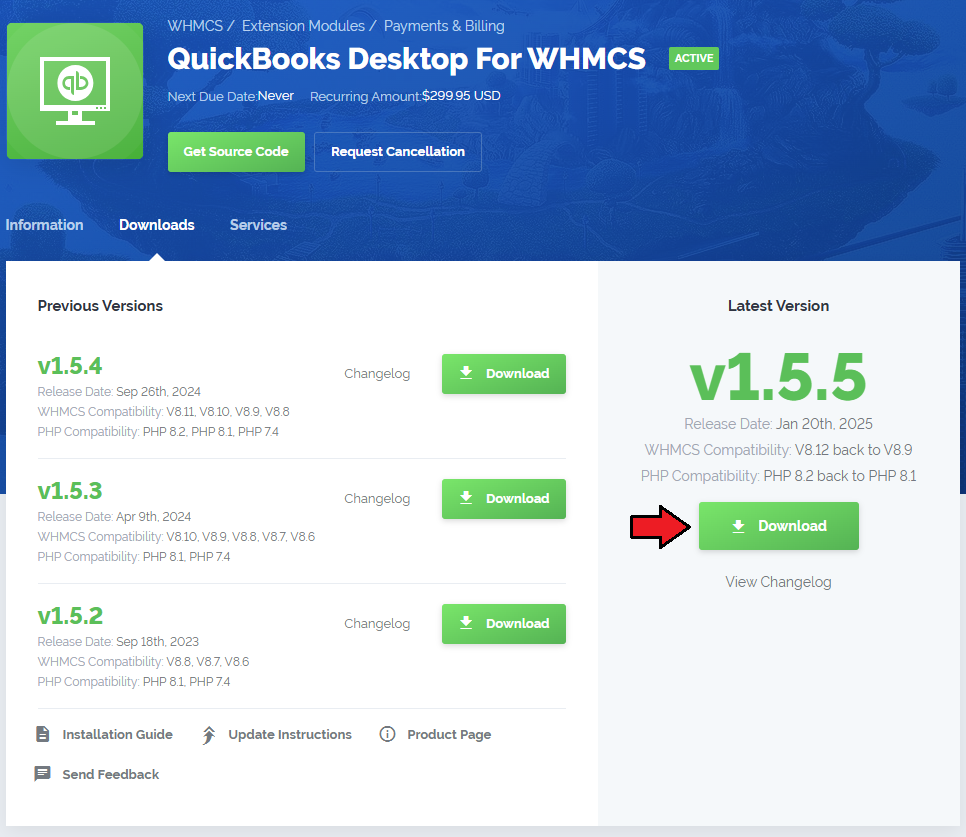
|
| 2. Upload and extract the module into the main WHMCS directory. Files in your WHMCS directory should look like on the following screen. |

|
| 3. When you install QuickBooks Desktop for the first time you have to rename 'license_RENAME.php' file. File is located in 'modules/addons/QuickBooks_Desktop/license_RENAME.php'. Rename it from 'license_RENAME.php' to 'license.php'. |
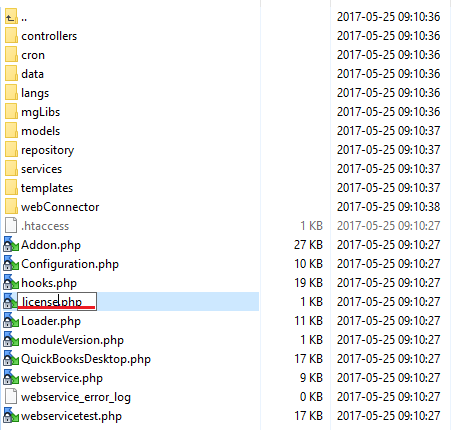
|
| 4. In order to configure your license key, you have to edit the previously renamed 'license.php' file. Enter your license key between quotation marks as presented on the following screen. You can find your license key in your client area → 'My Products'. |

|
| 5. Now you have to activate the module in your WHMCS system. Log in to your WHMCS admin area. Go to 'Setup' → 'Addon Modules' . Afterwards, find 'QuickBooks Desktop' and press 'Activate' button. |
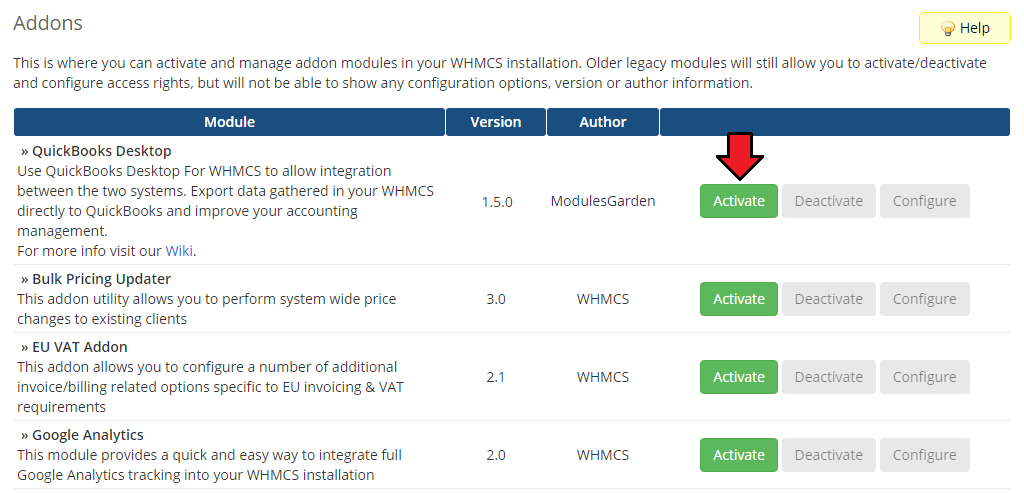
|
| 6. In the next step you need to permit access to this module. To do so, click on 'Configure' button, check required group of administrators and press 'Save Changes'. |
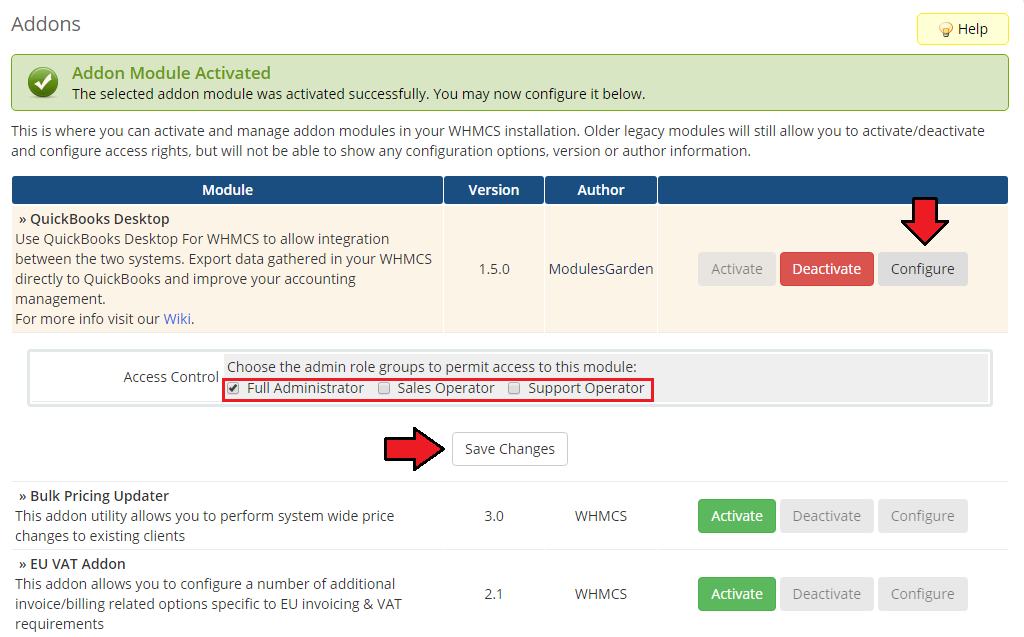
|
| 7. You have just successfully installed QuickBooks Desktop For WHMCS! You can access your module under 'Addons' → 'QuickBooks Desktop'. |
Configuration and Management
| QuickBooks Desktop For WHMCS is a module which allows you to export any data on clients, invoices and transactions directly to QuickBooks. |
Configuration
| 1. To configure your module properly, first you have to add new account. To do so proceed to 'Addons' → 'QuickBooks Desktop' → 'Settings' → 'Accounts'. |
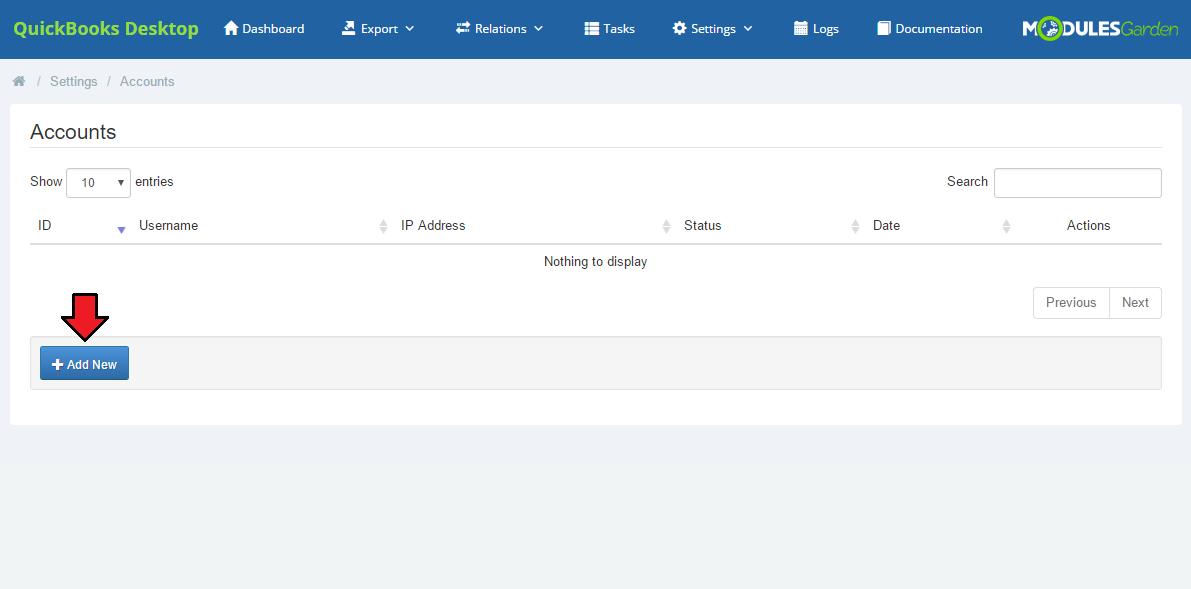
|
| In order to use the module fully, your account will be linked to Web Connector, a tool allowing integration beetween your WHMCS system and QuickBooks Desktop. Provide the necessary information. You can also define when the data will be synchronized automatically. |
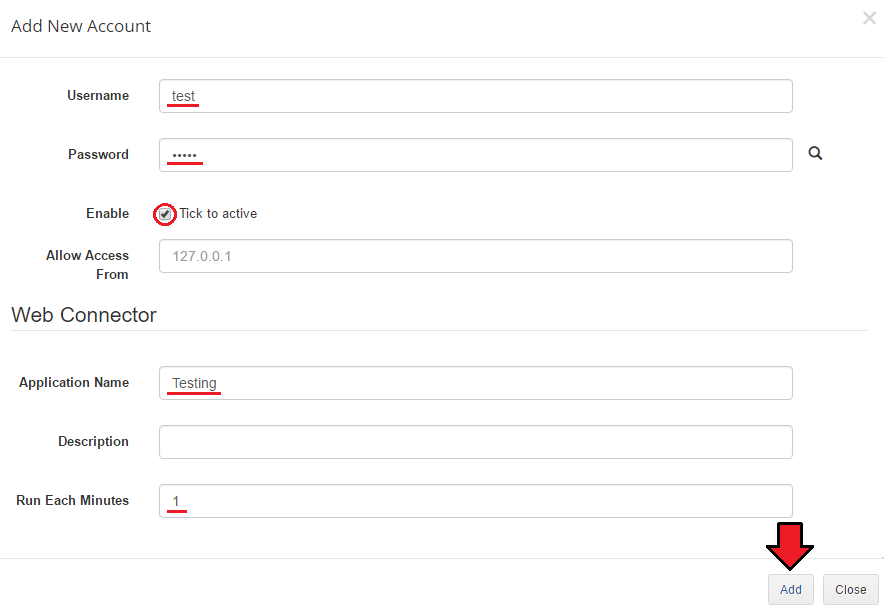
|
| Your account should appear on the list. It can be switched on/off, edited or deleted. For the proper configuration, you need to download the file for Web Connector now, as shown below. |
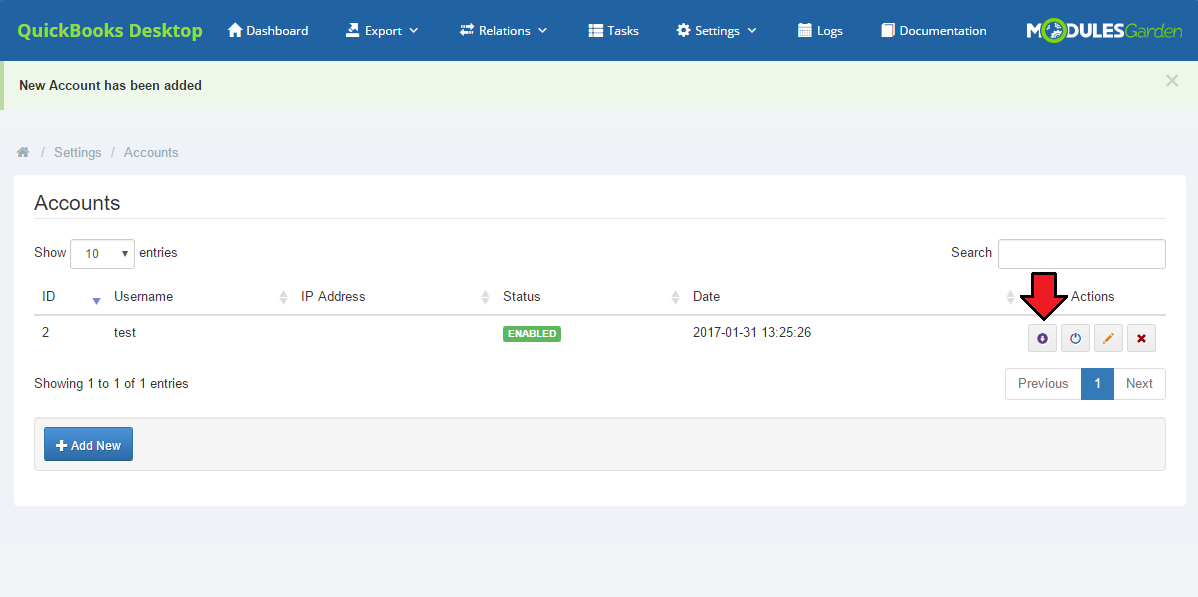
|
| Copy the file to the shared folder so it can be found in the virtual box ?? Then drop it onto desktop and click. An authorization box will appear and to grant the access through the QuickBooks Web Connector just click 'OK'. |
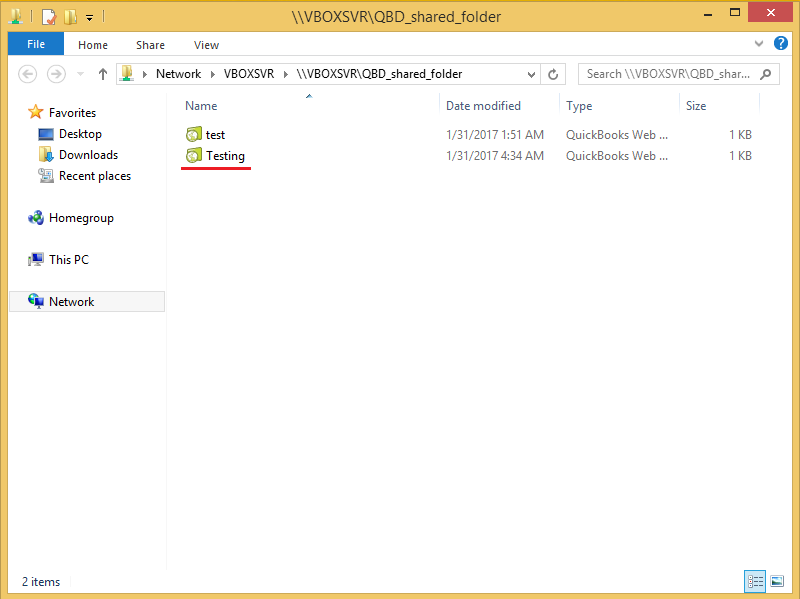
|
| You should see Web Connector window.
You have successfully added your account! |
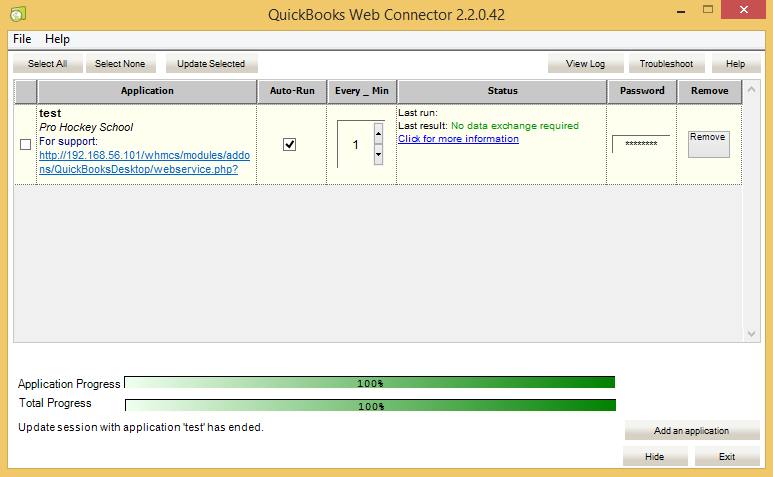
|
| 2. Synchronization Settings - decide which of the possible synchronization options you want to enable. Tick the ones you are interested in. |
| There are: Clients synchronization:
Invoices synchronization:
Payments synchronization:
Refunds synchronization:
Products synchronization:
Query synchronization:
|
| Apart from choosing required synchronization options, you have to decide here, which items from QuickBooks Desktop, 'Products ' and 'Domains' will be associated with. Note: Default Product will be used only when tehre is no relation set for the selected product in 'Relation: Product' section. Choose other options from the dropdown menu to set up.
Press Save Changes button. |
| You can also set the default task that will be run automatically. |
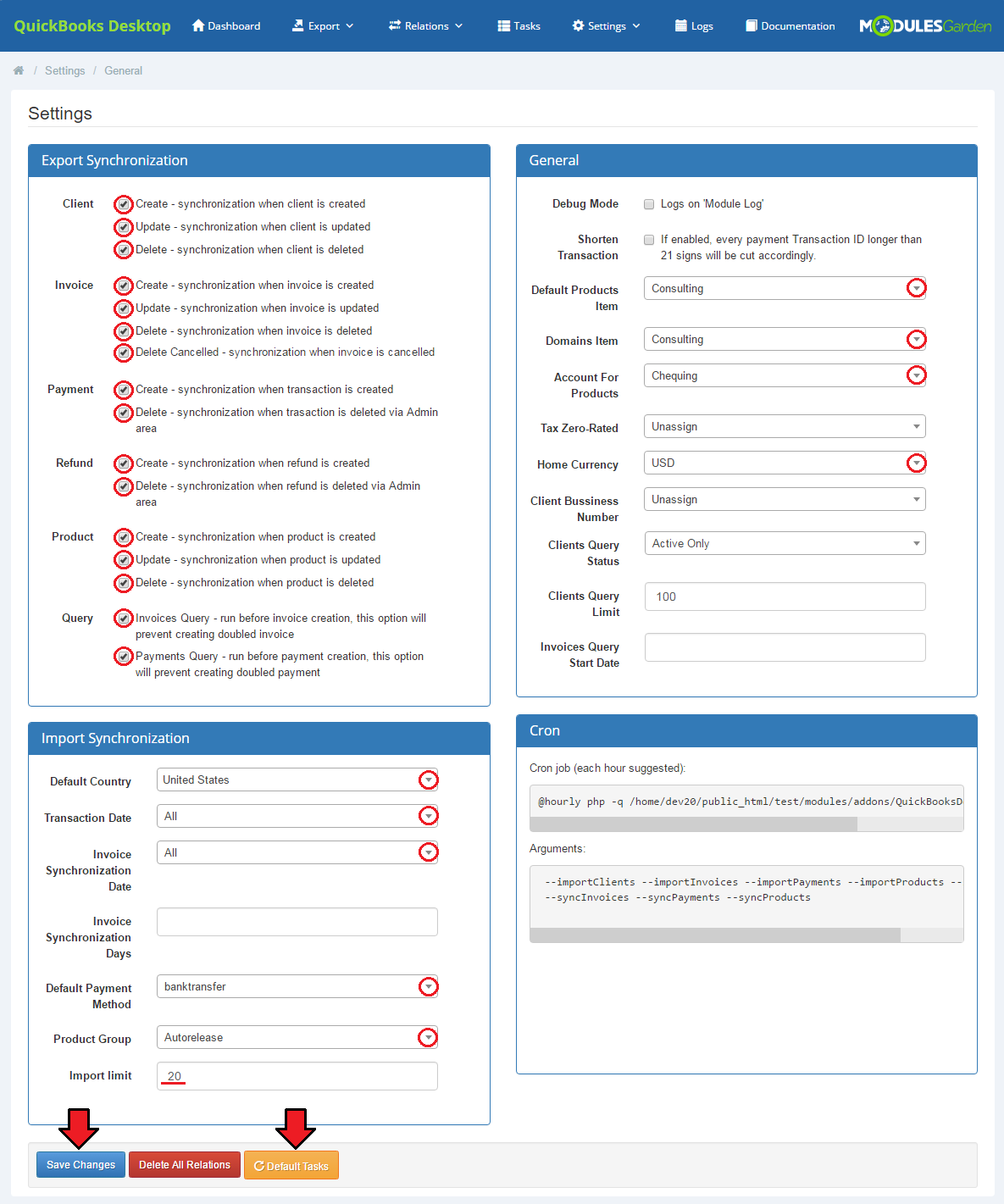
|
| All the tasks and their statuses will be displayed in Task tab. |
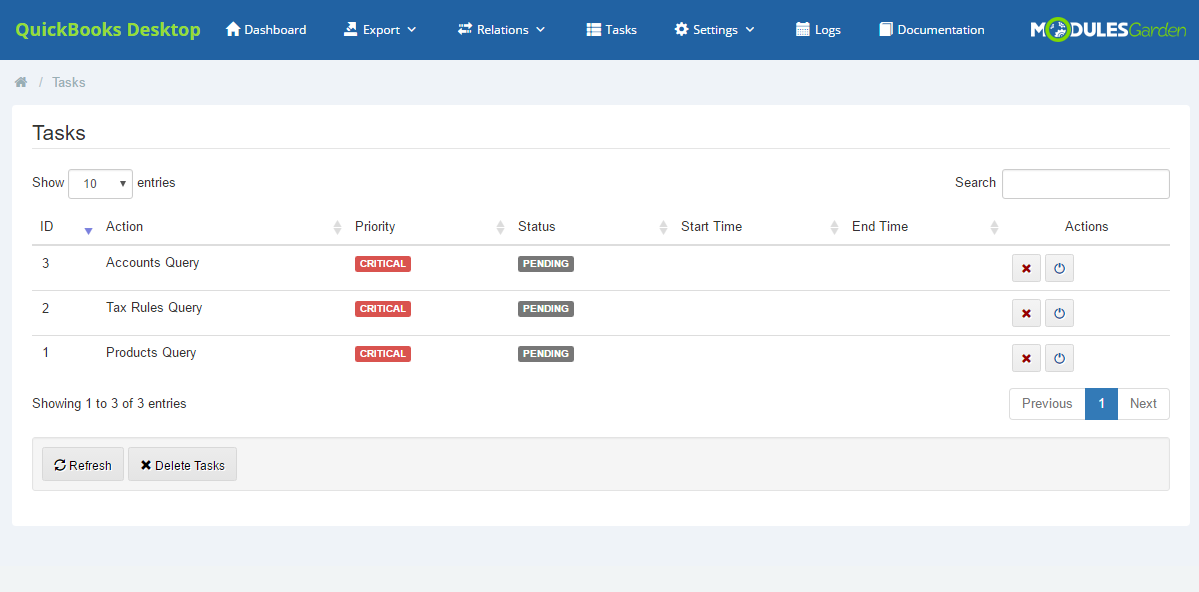
|
Management
| At this section we will show you the possibilities of QuickBooks Desktop For WHMCS. Once it has been properly connected with QuickBooks Desktop and all the configuration is now ready, we can move on to 'Export' section. |
Export
| Our module allows several ways to export any data gathered in your WHMCS. Read the below points to learn what data can be synchronized with QuickBooks Desktop and what are the possible means of such synchronizations. |
Clients
| The first option offered by our module is the export of clients from WHMCS to QuickBooks Desktop, proceed to 'Export' → 'Clients.' You will see here a list of all clients who exist in your WHMCS and have not been synchronized with QuickBooks yet. Use filter to find clients with their account created during the specified period of time. |
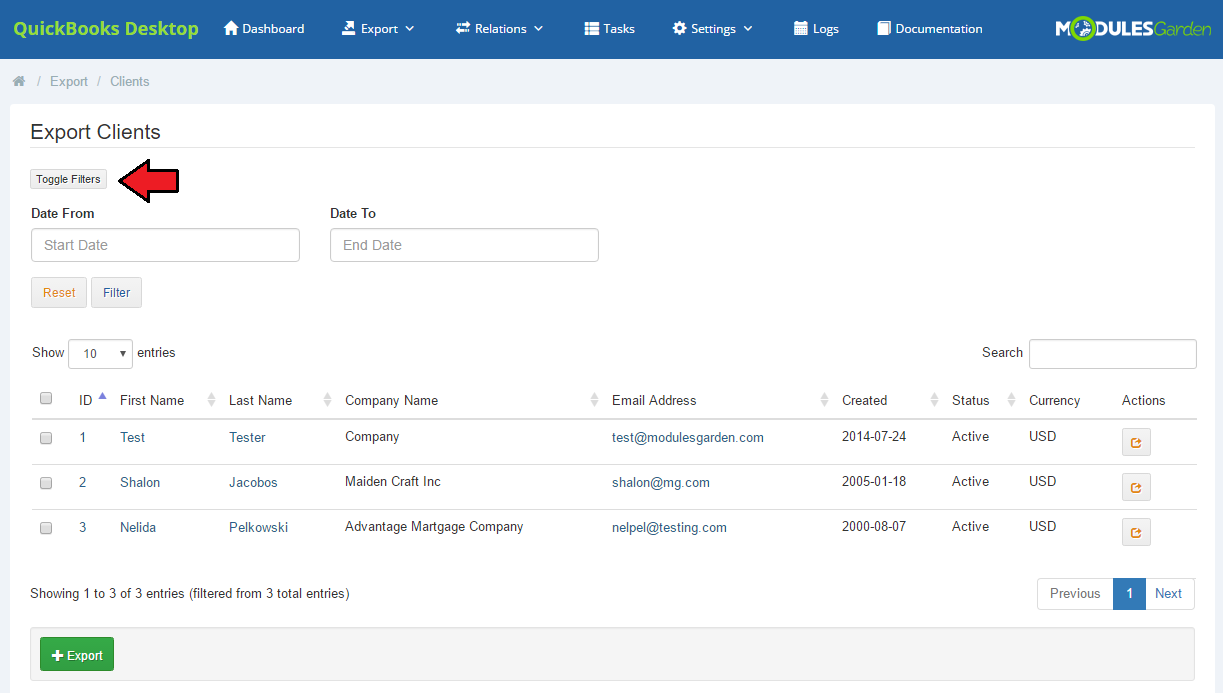
|
| Now, you can manually export all of the clients available on the list or choose only some of them. Check boxes next to the clients you are going to export and press 'Export' button as marked on the screen. If you want to export only one client you can do it by pressing 'Export' button located in 'Action' column next to the name of the client. |
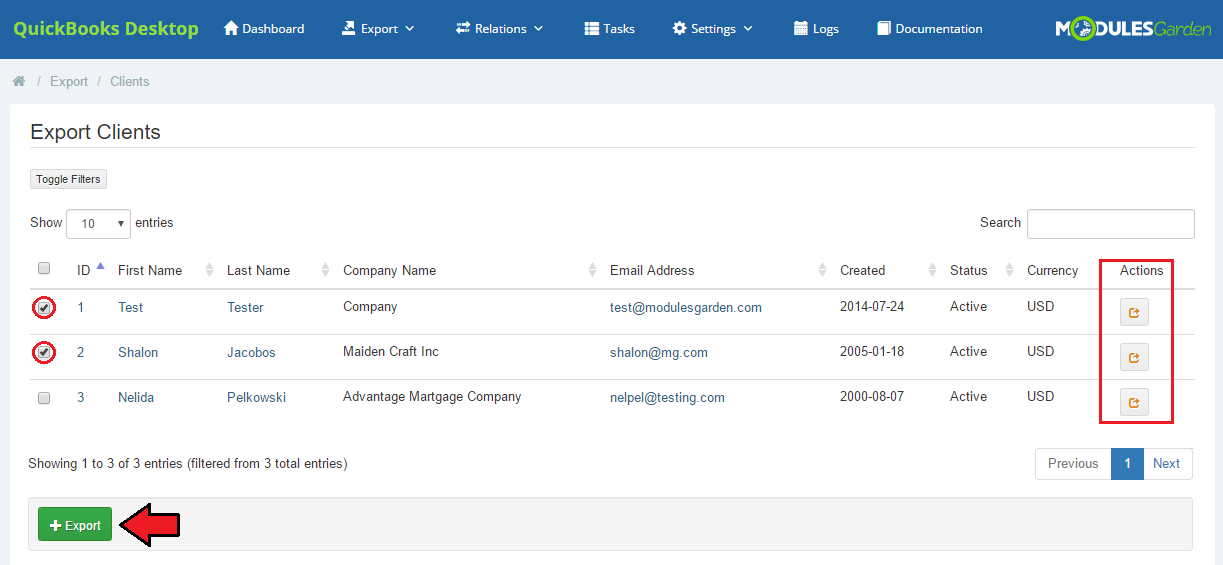
|
| If a client has already been exported from WHMCS to QuickBooks, they will no longer be visible on the list. All clients newly added to WHMCS will be automatically synchronized with QuickBooks unless otherwise stated in 'Synchronization Settings.' |
Invoices
| The other choice is the export of invoices. Proceed to 'Export' → 'Invoices' and you will find a list of all invoices existing in our WHMCS that have not been synchronized with QuickBooks yet. In details you will find information on the invoice:
|
Just like in case of clients:
|
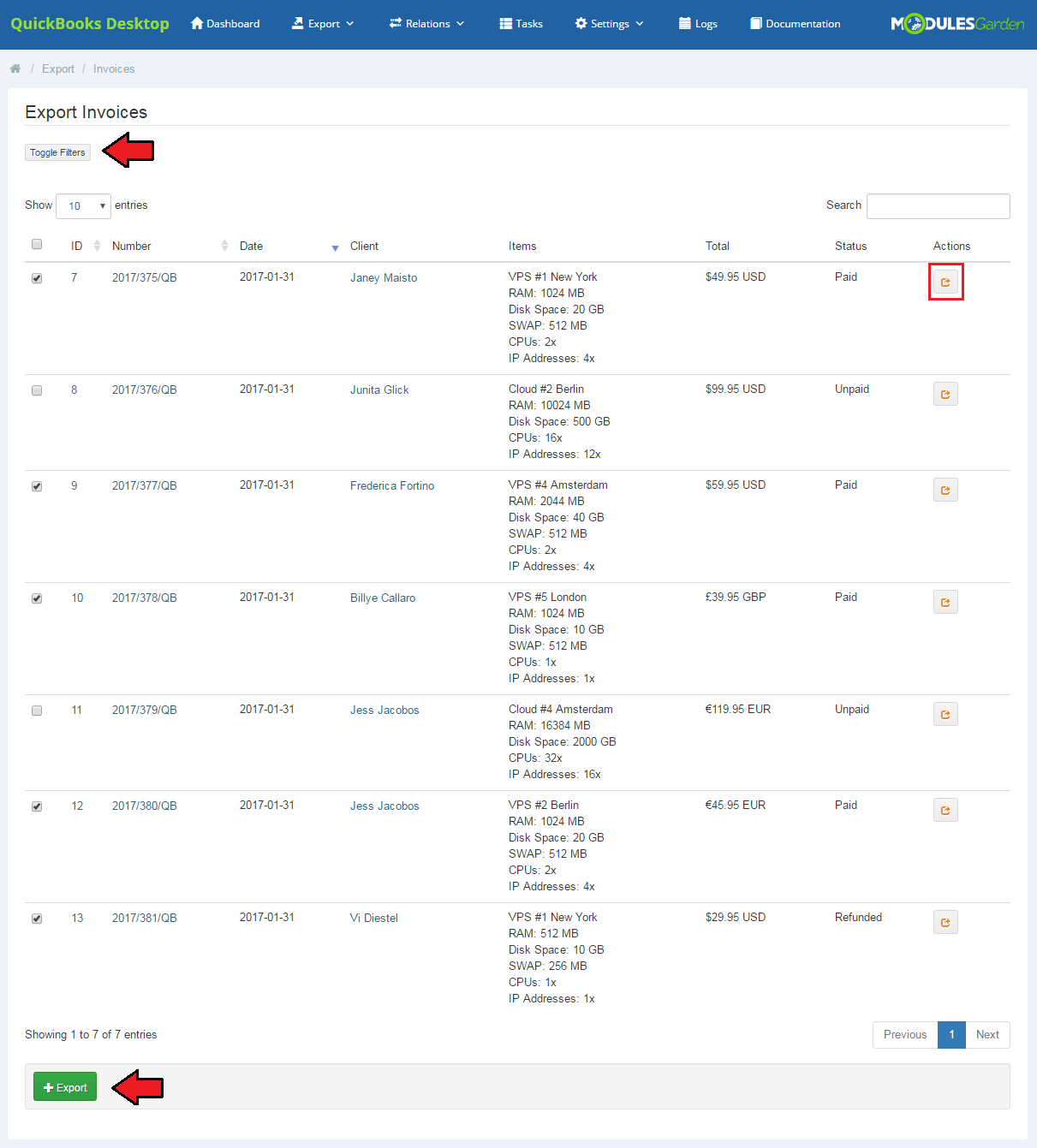
|
| Once you have exported some of the invoices you will see their number along with the number of any transactions connected with them in 'Summary' table on the dashboard. |
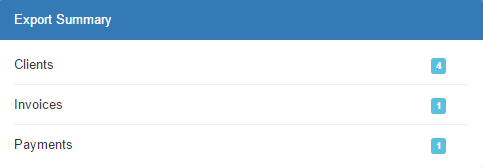
|
| Keep in mind that all newly added (after the first usage of QuickBooks For WHMCS) invoices and transactions are automatically synchronized and exported to QuickBooks Desktop unless otherwise stated in 'Synchronization Settings.' |
Relation
| It is possible to manually declare relations between WHMCS clients, products as well as invoices and corresponding to them QuickBooks Desktop elements. This feature is especially helpful when you need to avoid confusion and misunderstandings. |
Relation: Clients
| The first possible relations to be declared are relations between WHMCS clients and QuickBooks customers. Proceed to 'Relation' → 'Clients,' you will find there a list of all clients, with their email addresses, that exist in WHMCS, |
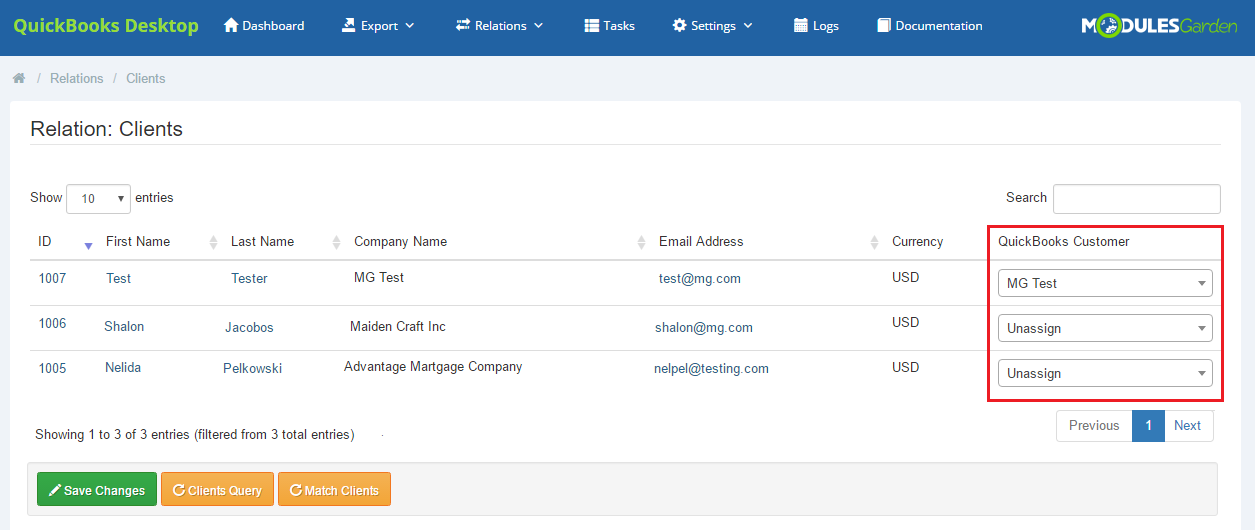
|
Relation: Custom Client Fields
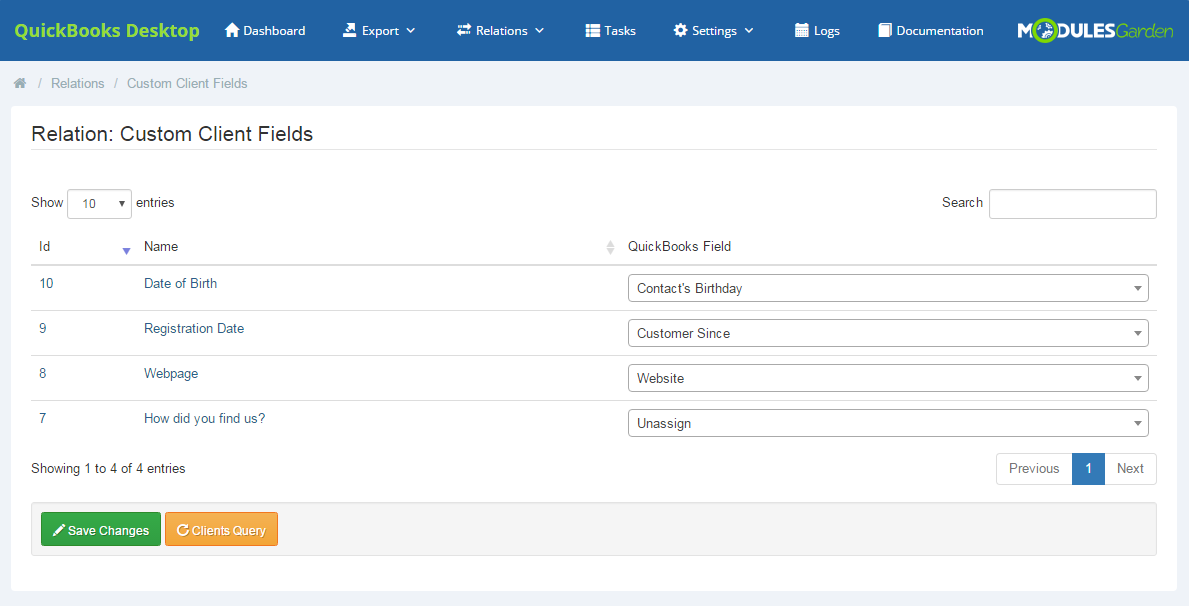
|
Relation: Products
| Products relations can be declared manually and for each product separately along with those declared in 'Configuration' → 'Synchronization Settings.' ' Proceed to 'Relation' → 'Products,' you will find there a list of all products with their type and payment standard. |
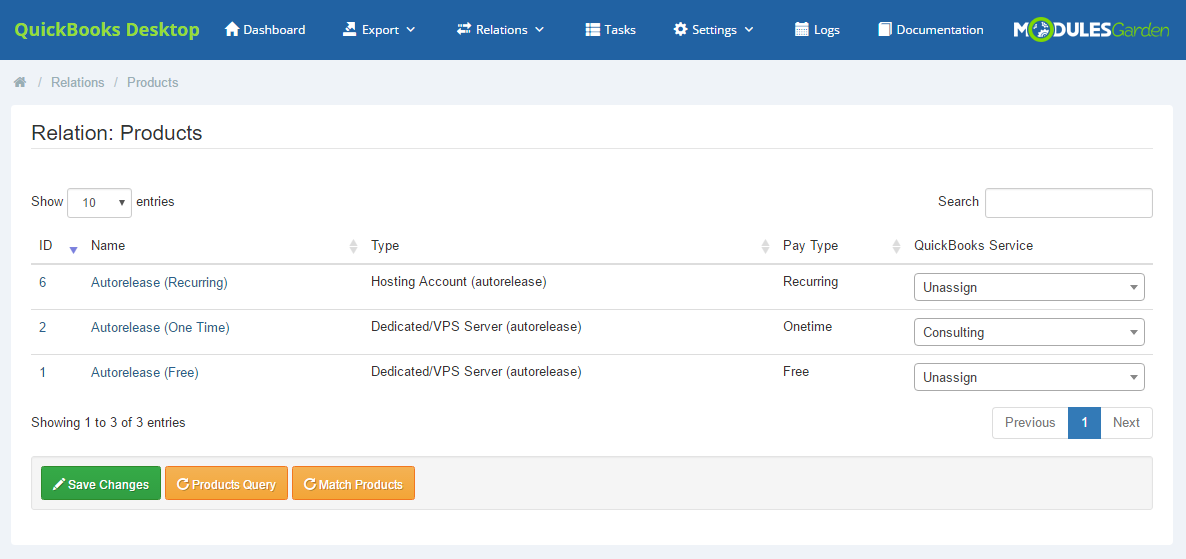
|
Relation: Invoices
| In 'Relation' → 'Invoices' directory, you will find a list of all WHMCS invoices with their ID, date of creation, assigned client, total sum on it and status. It is possible to assign such WHMCS invoice to another invoice already exported to QuickBooks Desktop. Just choose such from dropdown menu and save changes. |
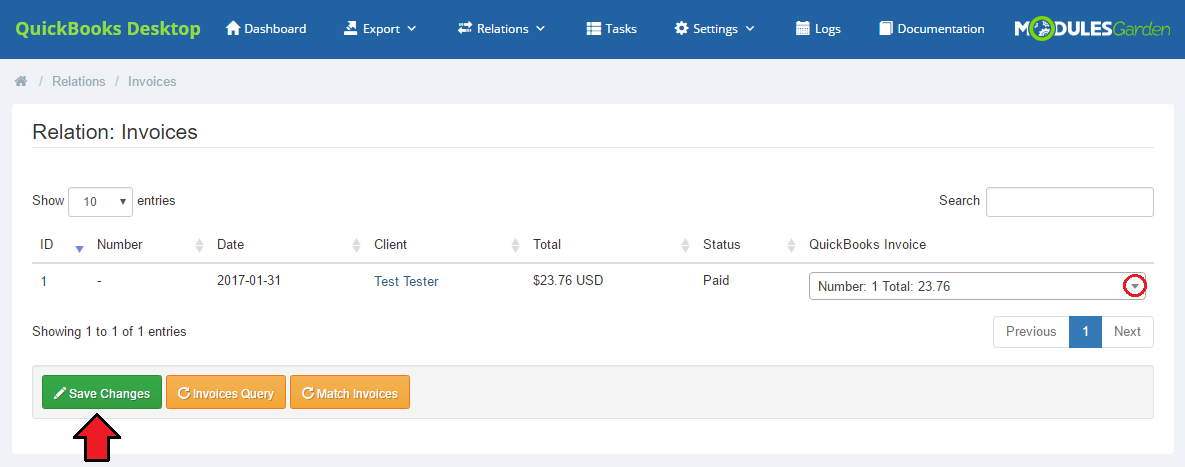
|
Relation: Tax Rules
| In 'Relation' → 'Tax Rules' directory, you will find a list of defined taxes rules. Assign each rule to a specific QuickBooks tax. Select one from a dropdown menu and save changes. |
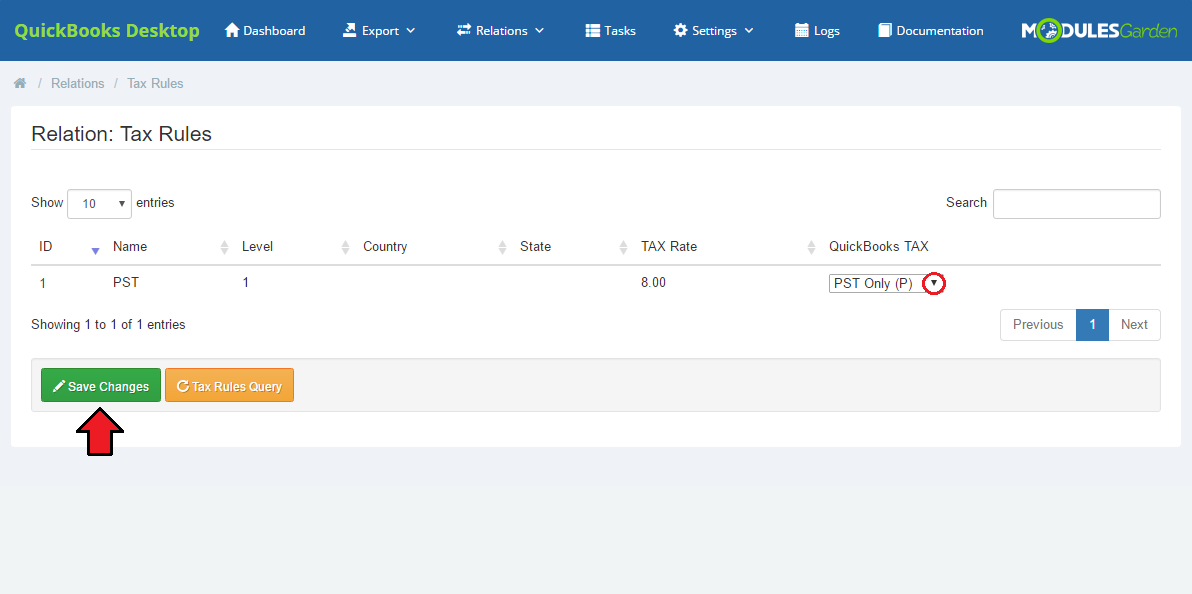
|
Relation: Currencies
| In 'Relation' → 'Currencies' directory, you will find a list of defined currencies. Assign each currency to a specific one from QuickBooks Desktop. Select one from a dropdown menu and save changes. |
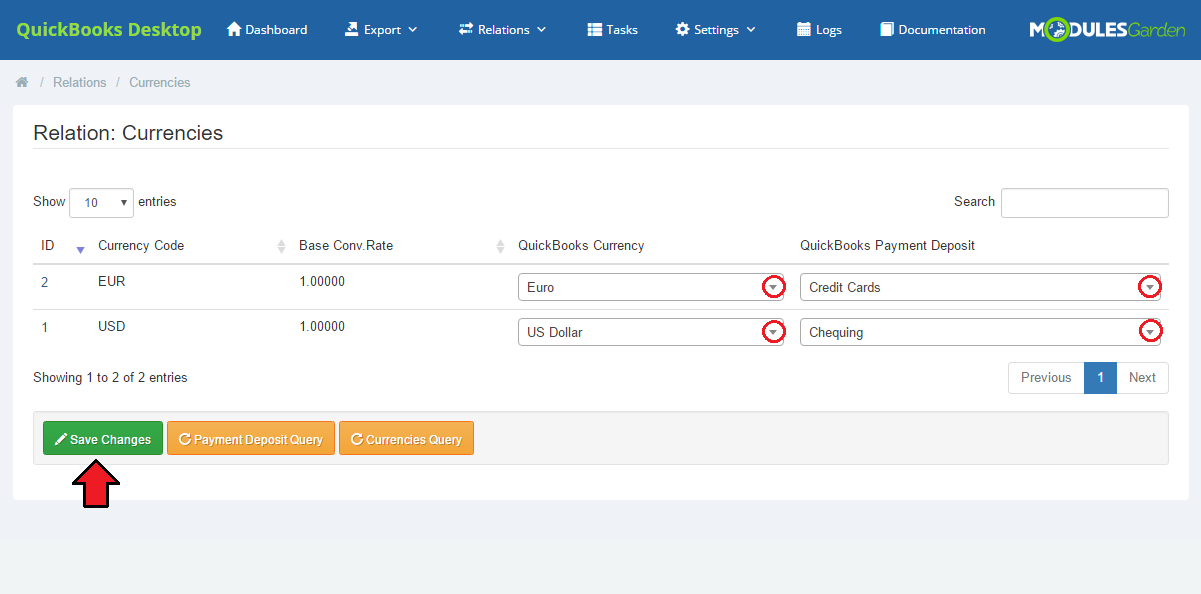
|
Cron Jobs
| Properly set up cron job with a recommended interval is responsible for synchronization of any updates done on invoices or clients' accounts. All changes will be immediately visible in QuickBooks, after cron job has run, without any additional actions taken manually from QuickBooks For WHMCS. |
Logs
| In 'Logs' tab there are enumerated ALL actions on clients, invoices and transactions. No matter if they were taken manually in the module, automatically or by a cron job. Find there a list of all entries with precisely described details and an exact date of the action. |
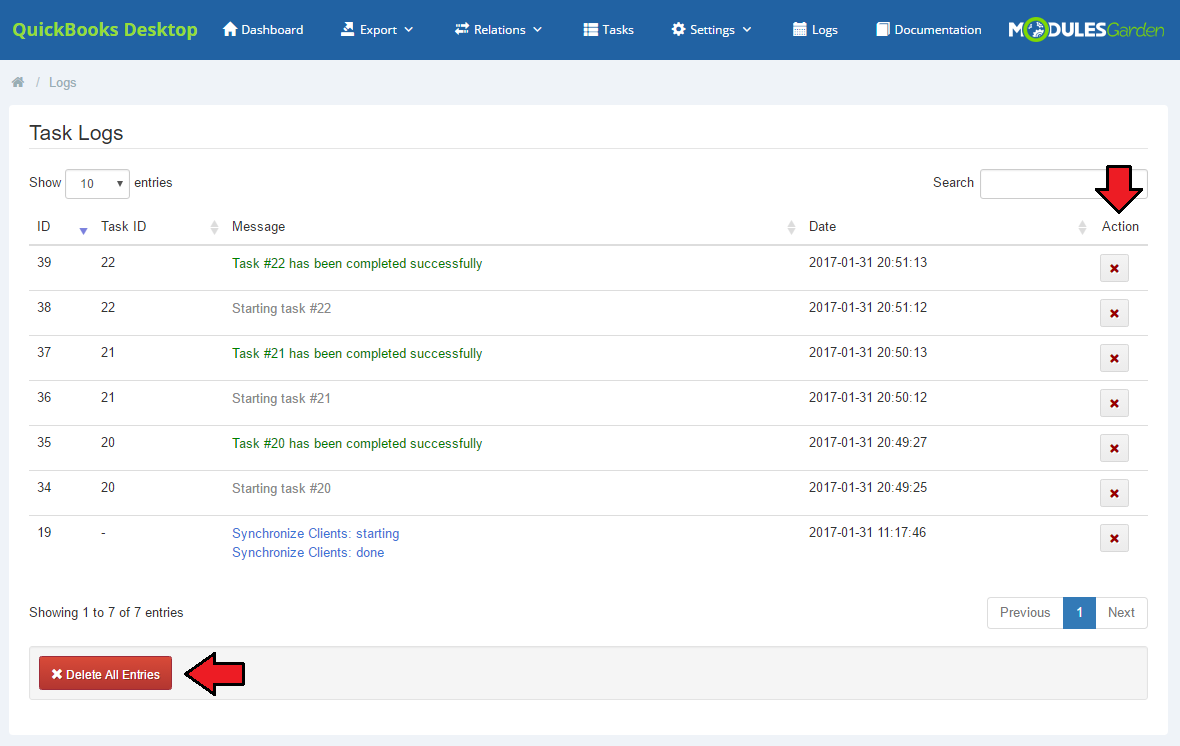
|
| Clear all the entries or delete only some of them. Use buttons marked on the screen above. |
Dashboard
| 'Dashboard' includes two useful and user-friendly tables. The first one, 'Export Summary' contains data on the number of exported clients, invoices and payments. |

|
Documentation
| The very last tab 'Documentation' once clicked will redirect you to the article you are currently reading! |
Tips
| 1. |
Common Problems
| 1. When you have problems with connection, check whether your SELinux or firewall does not block ports. |
| 2. |